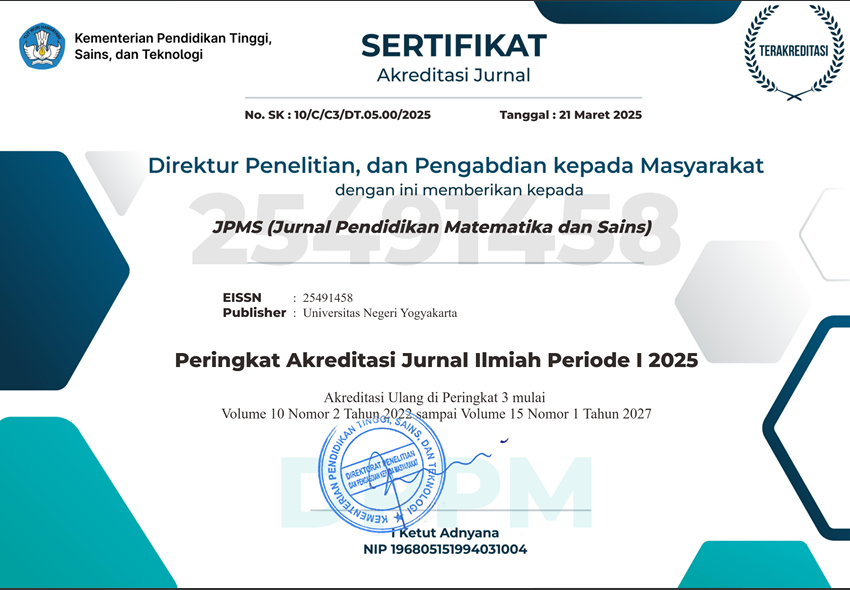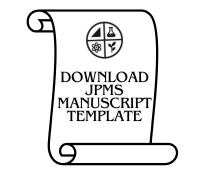Innovation of the LIRACLE Model: Case of Gajah Wong River Pollution by Pb Metal
DOI:
https://doi.org/10.21831/jpms.v13i2.84783Keywords:
Pb metal, LIRACLE learning model, Gajah wong river pollutionAbstract
Gajah Wong River is one of the rivers in Yogyakarta. Gajah Wong River is an aquatic ecosystem whose existence is greatly influenced by activities or activities around it or in the river basin. Several human activities cause pollution in this river. One of the pollutants found is Pb metal. Students, as a quality young generation, must be able to find alternative solutions to this problem. Literacy and Research-Oriented Cooperative Problem-Based Learning (LIRACLE) is a new learning model developed for learning in higher education. In its development, LIRACLE is used to develop chemical literacy skills, get used to scientific thinking, and develop the science process skills of prospective chemistry teachers. The purpose of this study is to describe the application of the LIRACLE model in the case of pollution of the Gajah Wong River by Pb metal. The description includes observations of the implementation of each syntax of LIRACLE. The number of water samples used in this study was taken from one point on the Gajah Wong River. The chemical concept studied is adsorption, the theory of which has been studied in the "Molecular Dynamics" course. The results of this study are descriptions of activities in each LIRACLE syntax in the case of Gajah Wong River pollution by Pb metal. This study is preliminary in the development of the LIRACLE model for the future
References
Akcay, B., & Benek, I. (2024). Problem-based learning in türkiye: a systematic literature review of research in science education, Education Science, 14(3). 330. https://doi.org/10.3390/educsci14030330
Barret, T. (2017). A new model of problem-based learning: inspiring concepts, practice strategies and case studies from higher education. All Ireland Society for Higher Education (AISHE).
Brilingaite, A., Bukauskas, L., & Juskeviciene, A. (2018). Competency assessment in problem-based learning projects of information technologies students. Informatics in Education, 17(1), 21–44. https://doi.org/10.15388/infedu.2018.02
Çalık, M., Ültay, N., Kolomuç, A., & Aytar, A. (2015). A cross-age study of science student teachers' chemistry attitudes. Chemistry Education Research and Practice, 16(2), 228–236. doi:10.1039/c4rp00133h
Cavadas, B., Rezio, S., Nogueria, J. R., & Branco, N. (2022). A framework and a reseacrh design proposal to identify preservice teachers’ integration performance of science and mathematics. Canadian Journal of Science, Mathematics, and Technology Education, 22. 101–129. https://doi.org/10.1007/s42330-022-00198-2
Cigdemoglu, C., Arslan, H. O., & Cam, A. (2017). Argumentation to foster preservice science teachers’ knowledge, competency, and attitude on the domains 237 of chemical literacy of acids and bases. Chemistry Education Research and Practice, 18(2), 288–303. doi:10.1039/c6rp00167j
Easa, E., & Blonder, R. (2024). Fostering inclusive learning: customized kits in chemistry education and their influence on self-efficacy, attitudes and achievements. Chemistry Education Research and Practice, https://doi.org/10.1039/D4RP00144C
Edwards, D., Carrier, J., Csontos, J., Evans, N., Elliot, M., Gillen, E., Hannigan, B., Lane, R., Williams, L. (2023). Review: Crisis responses for children and young people – systematic review of effectiveness, experiences, and service organisation (camh-crisis). Child and Adolescent Mental Health, 29(1), 70 – 83. https://doi.org/10.1111/camh.12639
Grant, M. M. (2002). Getting a grip on PBL: Theory, cases and recommendations. Meridian: A Middle School Computer Technologies Journal A Service Of NC State University, Raleigh, 5(1), 1–17
Keslair, F., & Paccagnella, M. (2020). Assessing adults’ skills on global scale: a joint analysis of results frim piaac and step. OECD Education Working Paper No. 230, 1–50. https://dx.doi.org/10.1787/ae2f95d5-en
Kristiyani, D., Susatyo, E. B., & Prasetya, A. T. (2012). Pemanfaatan zeolit abu sekam padi untuk menurunkan kadar ion Pb2+ pada air sumur. Indonesian Journal of Chemical Science, 1(1).
Melati, A., Sulistyawati, E., Nugraheni, I. (2017). Pengolahan limbah air sungai gajah wong yogyakarta berbasis masyarakat menggunakan aplikasi teknologi nano carbon dari bathok kelapa terintegrasi lahan basah buatan. Jurnal Bakti Saintek, 1(2), 47–54.
Muntholib., Ibnu, S., Rahayu, S., Fajaroh, F., Kusairi, S., & Kuswandi, B. (2020). Chemical literacy: performance of first year chemistry students on chemical kinetics. Indonesian Journal of Chemistry, 20(2), 468–482. DOI: 10.22146/ijc.43651
Perry, K.H., Shaw, D.M., & Saberimoghaddam, S. (2020). Literacy practices and the programme for the international assessment of adult competencies (piiac): a conceptual critique. International Review of Education, 66(1). https://doi.org/10.1007/s11159-019-09819-9
Pratama, F. I. (2022). Analisis kadar logam fe, pb, cu, zn, dan cd dalam air minum isi ulang di kecamatan depok sleman yogyakarta. Dalton: Jurnal Pendidikan Kimia dan Ilmu Kimia, 5(1), 38–44. http://dx.doi.org/10.31602/dl.v5i1.6468.
Pratama, F. I., Aznam, N., & Rohaeti, E. (2023). The study of chemical literacy related to chemical ethics based on local phenomena day-to day: a case of used cooking oil. Jurnal Penelitian Pendidikan IPA, 9(9), 6810–6818. https://doi.org/10.29303/jppipa.v9i9.3224
Pratama, F.I., & Rohaeti, E. (2023). Students’ Chemical Literacy Ability on Hydrocarbon Material: A Case of Toxic Compounds in Fried Food. Jurnal Penelitian Pendidikan IPA, 9(9), 6795–6802. https://doi.org/10.29303/jppipa.v9i9.4554.
Pratama, F. I., Rohaeti, E., Ariantika, D., Fauzia, S. D., Wulandari, N. I., & Pawestri, J. S. (2024). Penjabaran model literacy and research-oriented cooperative problem-based learning dalam kasus pencemaran air oleh logam fe . Jurnal Pendidikan Matematika dan Sains, 12(2), 132–138. https://dx.doi.org/10.21831/jpms.v12i2.79113
Pratama, F. I., Rohaeti, E., & Laksono, E. W. (2024). Empirical Foundations for Developing New Learning Models to Improve Chemical Literacy, Scientific Habits of Mind, and Science Process Skills of Chemistry Education Students. Jurnal Penelitian Pendidikan IPA, 10(10), 8062–8069. https://doi.org/10.29303/jppipa.v10i10.8661
Purba, M. P. (2019). Tantangan Kualitas Air Sumur dan Dampaknya terhadap Kesehatan. Jurnal Kesehatan Masyarakat, 10(1), 23-29.
Shankar, P. R. (2010). Problem-based learning: a review. Journal of Clinical and Diagnostic Retrieved from http://www.jcdr.in/article_fulltext.asp?issn=0973- 709x&year=2010&volume=&issue=&page=&issn=0973-709x&id=989
Stasevic, F., Miletic, N., Nikolic, J. D., & Gutman, I. (2023). Do Serbian high school students possess knowledge of basic chemical facts related to real life as prerequisite for chemical literacy? Journal of Serbian Chemical Society, 88(3), 343–354. https://doi.org/10.2298/JSC211126083S
Yang, X. (2023). A historical review of collaborative learning and cooperative learning. Tech Trends, 67. 718–728. https://doi.org/10.1007/s11528-022-00823-9
Downloads
Published
How to Cite
Issue
Section
Citation Check
License

This work is licensed under a Creative Commons Attribution-ShareAlike 4.0 International License.
Jurnal Pendidikan Matematika dan Sains allows readers to read, download, copy, distribute, print, search, or link to its articles' full texts and allows readers to use them for any other lawful purpose. The journal allows the author(s) to hold the copyright without restrictions. Finally, the journal allows the author(s) to retain publishing rights without restrictions
- Authors are allowed to archive their submitted article in an open access repository
- Authors are allowed to archive the final published article in an open access repository with an acknowledgment of its initial publication in this journal

This work is licensed under a Creative Commons Attribution-ShareAlike 4.0 Generic License.





